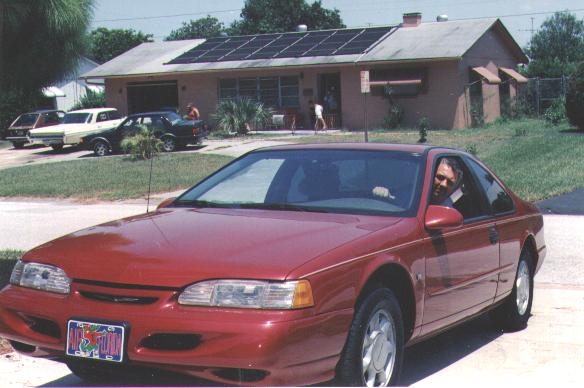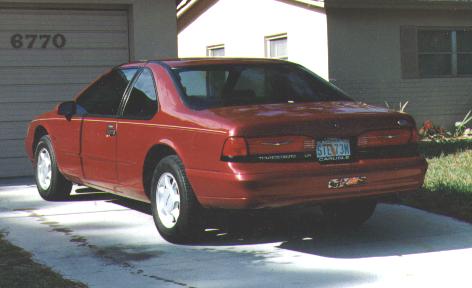 |
1994 Thunderbird |  |
This is my 1994 Ford Thunderbird LX. It has a 4.6 liter V8 and a junkie ford 4 speed automatic transmission (third one). Fast and quick.


"Numbers Removed"

See my T-Bird at 10 years old in 2004
Great Uncle Bill's Cars
This Is Your Great Uncle Bill
The Thunderbird began life with its introduction in 1955. It was introduced as a two-seat car with clean styling, creature comforts, and V8 refinement. Ford wanted to manufacture a car that could compete with the Chevrolet Corvette. For the 1955 model year, the Thunderbird was available with a 193-212 horsepower 292 cubic-inch V8. For the 1956 and 1957 model year, the Thunderbird was available with a 215-340 horsepower 312 cubic-inch V8 or the original 292 cubic-inch engine. In 1958, the Thunderbird was transformed into a four-seat car. It had boxy lines, a wide-pillar roof, and was one of the first personal luxury cars. From 1958 until 1960, the Thunderbird could be ordered with either a 353 cubic-inch, 300 horsepower V8 or a huge 430 cubic-inch, 350 horsepower V8. For the 1961 model year, the Thunderbird was again restyled with an all-new body shell which featured a severely pointed front "prow," modest fins above the traditional round taillights, quad headlamps recessed in oblong housings, and softer roof contours for the hard-top versions. The interior featured a dash that curved at its outboard ends to blend in with the door panels, and the first ever "Swing Away" steering wheel. The 390 cubic-inch V8 was available for the 1961, 62, and 63 model years and put out 300-340 horsepower. The next body change came in 1964 with the "Jet Bird" model line. The wheel base was stretched to 113 inches and the overall length of the car was 205 inches. This new body style consisted of shorter roof lines, newly designed rear-ends, and a longer hood and rear deck. The convertible option was still available during this model year, however, the Sports Convertible option was officially dropped. In 1965, the Thunderbird changed cosmetically with a reversed scoop behind the front wheels and a different front end. Also newly available for this model year were the disk brakes. 1966 saw more cosmetic changes such as a new grille, a single tail-light that ran the width of the back of the car, and new body sculpting. Also new for 1966 was the 428 cubic-inch engine, which was available along side the standard 390. The 1967 Thunderbirds were very different from their predecessors. They had a new chassis design and a 4-door option was now available. Also changed was the grille and headlight layout, which were designed to appear like a jet engine intake. The headlights on these model year cars were hidden. The four-door model had rear "suicide" doors which opened from the B-pillar. The engine options available for the 1967 model year are a 315 horsepower 390 cubic-inch V8 and a 345 horsepower 428 cubic-inch V8. 1967 saw the drop of the convertible model. The 1968 Thunderbird was not very different from its predecessor except for a new grille, which featured small Thunderbird emblems attached to each retractable headlight door. A person buying a '68 Thunderbird could have either a 390 cubic-inch 315 horsepower V8, a 428 cubic-inch 345 horsepower V8, or a 429 cubic-inch 360 horsepower V8. In 1969, the grille and the tail-light assemblies were changed. As with the '67 Thunderbird, the Thunderbird emblem was placed in the center of a mesh pattern grille. The single taillight was replaced with two taillights, each with a thunderbird emblem attached to their centers. Also, a sunroof option became available for the Thunderbird during this model year. The standard and only engine available for the Thunderbird in 1969 was the 429 cubic-inch 360 horsepower V8. For 1970, the body of the Thunderbird was redesigned. It had all new sheet metal and a V'd front grill which stuck out a good amount. The Thunderbird still had concealed headlights and came in a two-door or four-door version. In 1971, the Thunderbird was basically the same as it was in 1970, except for a redesigned front bumper and grill assembly. It still had the protruding nose and the four-door model was still available. The 1972 Thunderbird model year saw a much larger car emerge. It was only available as a two-door hardtop and took on a much more luxurious tone than did earlier Thunderbird models. The base engine was still the 429, but the consumer could also order the Lincoln 460 cubic-inch V8 as an extra cost option. For 1973, the Thunderbird saw small cosmetic changes such as an "egg crate" styled grill and dual headlights grouped individually instead of together. Also available for this year was the opera window, which would become standard equipment on Thunderbirds to come. The 429 cubic-inch engine was still the standard engine for the Thunderbird. The 1974 Thunderbird had little differences from the '73 model. One major difference was changing the standard engine to the 460 cubic-inch Lincoln V8. The 1975 Thunderbird was outfitted with many standard options which made it into a standard luxury car. The 460 cubic-inch engine was still the standard engine. 1976 was the biggest and most luxurious Thunderbird ever. After 1976, the size of the Thunderbird would dwindle and the performance would decrease. 1977 saw a Thunderbird that was almost 1000 lbs. lighter and almost a foot shorter. It was now built on a mid-size platform. It featured a wrap-around, body-colored band that went from one side of the body, over the roof, and ended at the other side of the body. The standard engine for 1977 was the 302 cubic-inch V8 while a 351 cubic-inch V8, and a 400 cubic-inch V8 were available at extra cost. The 1978 Thunderbird was not changed much from its predecessor. Newly available for this model year was the T-top option. The 1979 Thunderbird had the same body as its predecessors but had a redesigned grill and two individual tail lights instead of one wrap-around taillight. The 1980 Thunderbird was a unibody framed car, weighed 800 lbs. less than the 1979, and was 17 inches shorter. It was also more aerodynamic than its predecessors and as a result had better fuel mileage. This Thunderbird was available with either a 255 cubic-inch V8 or a 302 cubic-inch V8 with overdrive. In 1981, the Thunderbird for the first time was available with a 6-cylinder engine. The consumer could also purchase one of these cars with the 255 or the 302. Another change for the 1981 thunderbird was a revised grill treatment. In 1982, the Thunderbird was offered with a V6 alongside the inline 6 and 255 cubic-inch V8. This V6 allowed the Thunderbird to achieve a record 30 mpg. on the highway. 1983 was a monumental year for the Thunderbird. This year's Thunderbird was unidentifiable from its predecessors and featured a new aerodynamic look and was initially only available with the 3.8 liter V6. In February of 1983, however, Ford unveiled the Thunderbird Turbo coupe, a car that would put the Thunderbird name on the sports car wall. This car was available only with a 2.3 liter, turbocharged four-cylinder engine mated to a five-speed manual transmission. Another option that was added at the same time as the turbo coupes introduction was the 5.0 liter V8 model. The 1984 Thunderbird experienced very little changes except for the addition of the FILA and Elan models to run alongside the Turbo coupe and standard models. In 1985, the Thunderbird received interior changes such as a new gauge cluster and seat arrangements. On the outside, the '85 Thunderbird received a redesigned front grille, different tail light assemblies, and a new Thunderbird emblem. In 1986, the Thunderbird received an eight-injector port fuel injection system on its 302 engine and a third brake light for safety. The 1987 Thunderbird was a newly restyled aerodynamic bird. It had a redesigned front end that featured flush-mounted headlights, a new grill and a new front fascia. Also, the roof line was made more aerodynamic, the rear deck-lid was raised, and the taillight were redesigned. Other changes for 1987 include the dropping of the Elan model line and coming out with the Thunderbird Sport and the Thunderbird LX. The 1987 Thunderbird Turbo coupe was now putting out an awesome 190 horsepower when outfitted with the five-speed manual and 150 horsepower when outfitted with the automatic. There were no real significant changed for the 1988 model year. The Thunderbird which was introduced in 1989 was a completely new car. It had a longer wheel base and a wider stance than the previous Thunderbirds and it now featured a new independent rear suspension. The outside was completely redesigned and the standard and only engine available for this model year was the 3.8 liter V6. There were three models available for the 1989 Thunderbird: the Thunderbird, Thunderbird LX, and Thunderbird SC. The Thunderbird Super Coupe featured a 215 horsepower Super-charged 3.8 liter V6, dual exhaust, four-wheel disk brakes, and special front and rear end treatments. The 1990 Thunderbird was almost unchanged from the 1989 model. In 1991, the Thunderbird was offered with a V8. In 1992, the Thunderbird LX and base Thunderbird received redesigned front fascias and a full-width taillight. 1993 saw the drop of the Thunderbird Sport and base Thunderbird models. Instead, the Thunderbird LX and Thunderbird SC had complete control of the model line. In 1994, Ford changed the front end by giving it a new hood, head lights, and bumper design. Also, the 1994 Thunderbird received an interior change and a 4.6 liter V8. The Thunderbird Super coupe boasted 230 horsepower for the 1994 model year. The 1995 Thunderbird was much the same as it was in 1994. For 1996, the Thunderbird received exterior changes such as a revised nose that featured a smoother bumper. The 1997 model year saw once again a revised nose and a general smoothing out of the fender lines etc. 1997 was the last model year for the Ford Thunderbird, until its restyling and re-introduction in 2002 as a modernized design of the vintage models.
| Bill & Jackie's |
 |
Copyright © 2001 - 2005 Great Uncle Bill